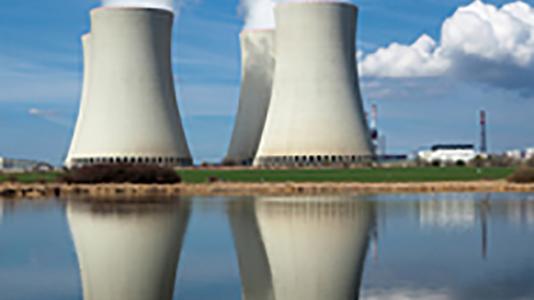
The turbines that spin inside them to generate electricity require tons and tons of steam, and all that water has to come from somewhere.
Recent studies have estimated that roughly 40 percent of the nation’s freshwater withdrawals and three percent of overall freshwater consumption goes to supplying the steam generators at large power stations in the United States. In order to cut down on the enormous quantities of water required to operate these plants, scientists have begun to look for new technologies that could improve their efficiency and reduce the demand for water.
Researchers at the U.S. Department of Energy’s Argonne National Laboratory are developing a special class of nanoparticles intended to cut the amount of water lost from steam-based generators.
Electrical plants use partially condensed high-temperature steam to turn a large turbine. After it goes through the turbines, the steam has to be cooled down in a condenser, transferring the heat to circulating water. To dissipate the heat, the water is partially evaporated in the cooling tower, which means some of it is lost to the atmosphere.
“In every cycle, there’s a significant amount of water that we can’t recapture,” said Argonne materials scientist Dileep Singh, who is working to develop specialized nanoparticles to address this problem.
Adding nanoparticles to the circulating water system has two benefits: it allows the water to pick up more heat, and reduces the amount of water lost while still dissipating the same amount of heat. “Using these multifunctional nanoparticles in the water system should provide enhanced apparent heat of vaporization, increased heat capacity and improved thermal properties,” Singh said.
The nanoparticles are based on what is known as a “core-shell” configuration, in which a solid outer coat protects an inner core that can melt above a certain temperature. Once dispersed in the plant’s water supply, the nanoparticles are able to absorb heat during the thermal cycle. After partially melting, the particles travel to the cooling tower where they resolidify. Thus, the system needs less water to pick up the same amount of heat. The system is closed and designed to ensure against leakage of the plant’s steam into the environment.
At the molecular level, Singh and his colleagues are especially concerned with the nanoparticles’ surface, as the chemistry at the boundary between the shell and the water determines its effect on the evaporation characteristics. “We’re experimenting with looking at the bonding between the particles and the water molecules,” he said.
“Growing your energy production in an environmentally responsible way involves worrying about how you manage your water resources,” Singh added.
The Electric Power Research Institute (EPRI), as part of its Breakthrough Technology program exploring high-risk, high-reward concepts, is providing funding to Argonne to develop and demonstrate the concept.
The vast quantities of water needed to operate these facilities will necessitate mass production of the nanoparticles once they are commercially developed, a fact that could potentially complicate the research and development process, said Thomas Ewing, Argonne associate divison director of nuclear engineering. “As we begin lab testing, we need to keep in mind the costs and issues associated with making this work in a real live power plant,” he said. “There are lots of tradeoffs to take into account.”
According to Ewing, Argonne is working with the EPRI and other partners to move this basic technology quickly through the developmental pipeline. Initial plans call for beginning the demonstration of proof of concept this year, and beginning full-scale commercial deployment in four years. “It’s practically unheard of for industry to seek to deploy a new technology so quickly,” Ewing said. “However, water consumption is a major issue that limits the expansion of power. If we want to solve the energy crisis, we’ll have to move boldly.”
Other Argonne project team members are Elena Timofeeva and David France.
Argonne National Laboratory seeks solutions to pressing national problems in science and technology. The nation’s first national laboratory, Argonne conducts leading-edge basic and applied scientific research in virtually every scientific discipline. Argonne researchers work closely with researchers from hundreds of companies, universities, and federal, state and municipal agencies to help them solve their specific problems, advance America’s scientific leadership and prepare the nation for a better future. With employees from more than 60 nations, Argonne is managed by UChicago Argonne, LLC for the U.S. Department of Energy’s Office of Science.